#boatswithcharacter – With the hope that boat numbers will start to increase again as we emerge from recession, categorisation resumes its central place in our thinking about the different types of craft we sail. Yet for a while, when the economy was at its nadir, you could classify your boat in almost any way you liked so long as you at least went out sailing, and kept fleet numbers at some sort of viable level.
But with things now on the move once more, some folk reckon they can afford to become a little more pernickety. For instance, the word is that the Old Gaffers Association may be going to insist that its racing awards can only be won by properly gaff-rigged boats. Yet when they were celebrating their Golden Jubilee in 2013 when the times were very thin indeed, some venerable but Bermudan-rigged craft were allowed to have a meaningful role. And if this was queried by some pedant, the official response was that they were actually setting gaff mainsails which just happened to be three-sided, and this was only as a temporary measure in response to the straitened times......
Quite so. But W M Nixon reckons that in the end, regardless of a boat's alleged type, it is character that is the final arbiter of quality both in the boats and their owners. In an exploration of this, he takes us on a virtual voyage from the Isle of Man to Achill Island, taking in some varied boat festivals on the way.
With boats as with people, it's character that counts. There are those of us who'd reckon there's more character in a battle-scarred all-plastic Cookson 50 than in a contemporary all-wood clinical re-creation of the design style of a previous era for what is known as "The Spirit of Classics" division. Though even here, the boats can begin to get some interesting character if they manage to get roughed about a bit - too much perfection is not good for the soul.
So give us a rough diamond any day, and in unusual boats, as with their owners, the waters around Ireland and nearby places have an abundance of them. One real diamond geezer is Joe Pennington from Ramsey in the Isle of Man. It always makes things that bit more right with the world when Joe comes into port with his workmanlike Manx longliner Master Frank, for Master Frank looks right, and is right – this is classic traditional, gold standard.
So it's ironic that although Joe is one of the Isle of Man's great sailing ambassadors, he's actually from north Lancashire. But he ended up working in the island as a carpenter, and failed to get off. The island, that is...As for his carpentry skills, they were up-graded to shipwright level, but he kept going as a carpenter as there was plenty of work around houses, while at same time restoring the Albert Strange yawl Emerald for his own use.
As he was based in Ramsey in the north of the island, he was very aware that it was the home port of the the last surviving Manx longliner, Master Frank built in 1895, the rapidly deteriorating example of an almost extinct species mouldering away in that very tidal harbour. People had realized the old boat's importance so much that the Manx government had been persuaded to buy her. But as with the Asgard in Ireland in the 1960s, the government may have bought her, but then they hadn't a clue what to do with her.
So one fine day, so the story goes, Joe in his working overalls marched into the Manx parliament, the House of Keys in Douglas, and berated the members for their neglect of this priceless example of the island's maritime heritage. They were flummoxed. So when he then offered to take on full responsibility for the Master Frank if they'd sell her to him with all rights for just one pound, they agreed, as enough was known about what he'd done with the Emerald to convince the assembly that this was their one last and best chance.
Restoring the Master Frank was in effect a re-build, and we have to remember that Joe was working fulltime in his day job as a carpenter. Yet he set himself a work schedule which gives you some idea of his depth of character. Many of us know Joe as a gregarious party animal. And as his appearance is something of a mixture between a gypsy king and the dangerous younger brother of a Roman Emperor, he certainly looks the part. But in order to bring the Master Frank back to life, he took the lonely route of coming home each evening after a day's work, having his tea, and then heading out that night for what was in effect another full day's work, but this time on the boat.

Most of us know Joe Pennington as a gregarious party animal, as seen here in the Peel S & CrC in the Isle of Man with Dickie Gomes of Ainmara and Stu Spence of Madcap.....Photo: W M Nixon
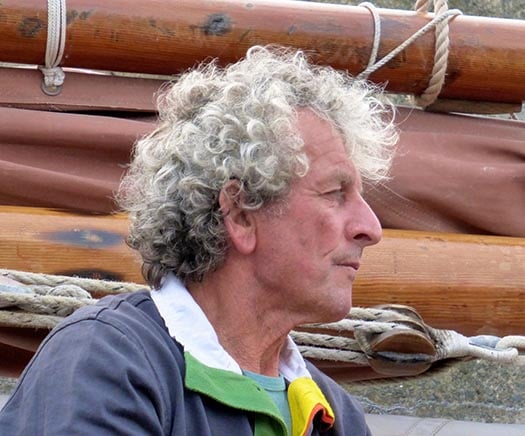
....but there's a serious and determined side to him, and he was just the man to save the very special Master Frank from extinction. Photo: W M Nixon
Night after night, week after week, the project went on, and when Master Frank was re-born, it was utterly worth the effort. Though she's only 36ft in overall hull length, she has the spirit of a much larger vessel, and her character is such that when she turns up at some assembly of classic and traditional craft, the event is a success even if only half a dozen other boats are taking part.
Just how much we'll see of her in Ireland this summer is in the lap of the Gods, as Joe likes to do a lot of cruising with his beloved boat, and Brittany calls. Master Frank is comfortable at sea, though like many workboats her actual hull freeboard is quite low – it's only the high bulwarks which seem to give her plenty of clearance.

Even in this light breeze off Peel in the Isle of Man, the restored Master Frank shows her class. Photo: W M Nixon
Thus it's normal to have some water on deck when the going starts to get brisk, and this is a characteristic also seen on the famous former pilot cuter Jolie Brise. The noted photographer Brian Carlin captured this to perfection when Jolie Brise went out to the Fastnet Rock during the Glandore Classics in 2013, which happened to be the old pilot cutter's Centenary. She went round in style, but there was no lack of water on deck, and we are reminded of the designer Jack Laurent Giles' comments. After crewing offshore on Jolie Brise when he was still a trainee naval architect, his assertion was that in anything over Force 3 on Jolie Brise, you needed to wear your seaboots, but presumably you were otherwise perfectly comfortable until Force 8 or thereabouts.
 Low freeboard and heavy displacement mean water on deck, but the famous Jolie Brise is otherwise comfortable as she rounds the Fastet to celebrate her Centenary in 2013. Photo: Brian Carlin
Low freeboard and heavy displacement mean water on deck, but the famous Jolie Brise is otherwise comfortable as she rounds the Fastet to celebrate her Centenary in 2013. Photo: Brian Carlin
But while workboats like Jolie Brise and Master Frank needed low hull freeboard with high bulwarks to help them fulfill their allotted tasks, the hookers of Galway Bay were primarily people and cargo carriers, thus they have ample freeboard and are notably dry on deck. But as with the old longliner and the old pilot cutter, at crucial times in their histories the Galway Hookers have needed some determined characters working on their behalf to survive in any shape or form, and while their fleet numbers are now well up, there have been times when they seemed on the brink of extinction.
This was particularly the case in the 1960s. These days we know Dennis Aylmer of Dun Laoghaire as an ever-young senior sailor who relishes his time aboard his neat Cornish Crabber Mona. But the reality is that, more than most, Dennis has earned the right to relax with his "plastic fantastic". For in 1964 and 1965, having toured Connemara as a decidedly impecunious and very young man on his bicycle and then on a tiny motorbike searching for an authentic Galway hooker, he bought the big Morning Star at Tierna on Gorumna Island, and somehow found the resources to have her restored to basic seaworthiness, and then he brought her back to Dun Laoghaire.
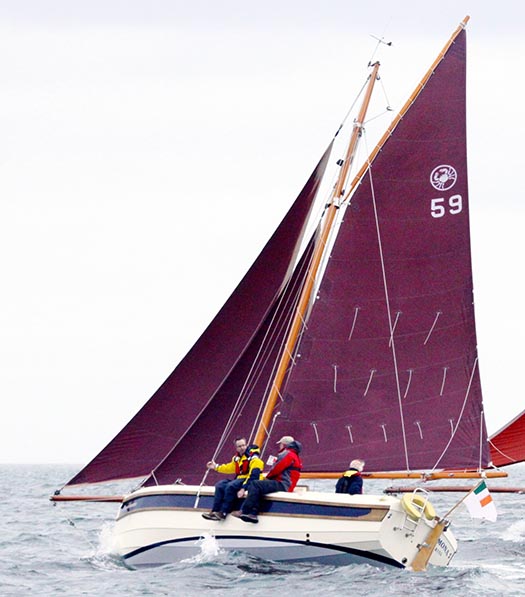
Traditional boat veteran Dennis Aylmer racing his very manageable Cornish Crabber Mona. Photo: Dave Owens
Though there were those who helped the young Aylmer in keeping the Morning Star going, in truth Dun Laoghaire in the 1960s was not a sympathetic environment for rough old gaff-rigged wooden craft. The Dublin Bay 21s had recently converted to Bermudan rig, and fibreglass was in the ascendant, with what amounted to the nucleus of a class of van de Stadt designed 36ft Excaliburs, which had a minimum of timber anywhere in their makeup.
And as work took her owner away for long periods, Morning Star's survival depended on the kindness of others. But somehow she stayed together one way or another until Johnny Healion took her over and gave her a mighty restoration for 1976 which, even on the shores of Galway Bay, was acknowledged as the initiative which led to a reversal in the decline of the old boats.
At one stage there was quite a fleet of restored Galway Hookers of all sizes in the Dublin area and along Ireland's East Coast, and they used to put in their most spectacular appearances at the Portaferry Traditional Boat Regatta in late June (this year's is 26th to 28th June 2015).
But two developments have seen the Galway Hookers' centre of gravity move very positively back to the west. The proliferation of marinas along the east coast is not bowsprit-friendly – old gaffers need a lot of pontoon length and ample manoeuvring space. And the M4 and the M6 have arrived. With Dublin coastal traffic being what it is, thanks to the motorway across Ireland to Galway, tradboat enthusiasts can get to gaffer Nirvanas like Kinvara almost as quickly as they can get to Dun Laoghaire or Howth, and they're more surely among kindred spirits when they get out west.
So although the most sacred gathering of the Galway Hookers is off Connemara at St MacDara's Island on the Saint's day, July 16th, the fleet of traditional boats around Galway Bay is really only up to full power with Cruinniu na mBad at Kinvara, which this year is August 14th to 16th.
The way that Kinvara's natural harbour is shaped, with the hospitable village and its quays at the head of a narrowing inlet which runs north and south to conveniently facilitate boats racing in the prevailing westerlies, means that this is one of the few places where sailing can comfortably become a spectator sport, and the badoiri revel in the close quarters challenges which Kinvara offers.
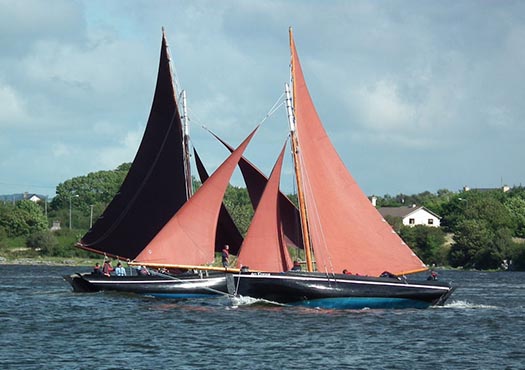
Close quarters Galway Hooker racing at its most visible – it can only be Kinvara.
However, the place becomes so crowded on the festival weekend that you might like to get your required ration of traditional boats elsewhere. But the problem is that while the sailors just want to get on with sailing among other like-minded souls on ancient craft, the organisers are usually in the numbers game, and they want to pack the pierheads and fill the vantage points with avid spectators.
It's all a long way from the long hours of solitary work which have gone into the maintenance of old boats, for which it's said the three essentials are a friend with a low-loader, a hayshed out the back of the house, and a very tolerant wife. Yet those are only the most basic requirements. When you see a gathering of traditional and classic boats in all their finery, what you're seeing is the coming together of people of real character who have had a dream, and they've stayed with it.
And if you're there at the local sea festival time, it will give you added insight into the neighbourhood. You'd be busy every summer weekend if you went with every sort of classic boat assembly, whether sailed, rowed or paddled, but if we just stick with the sailing, we find that there's a pattern which can indeed take us from the Isle of Man to Achill, and many places north and south of them as well.
They start early at Baltimore in West Cork, which could reasonably claim to be the headquarters of diversity in traditional craft, and this is celebrated from May 22nd to 24th this year with the Baltimore Wooden Boat Festival.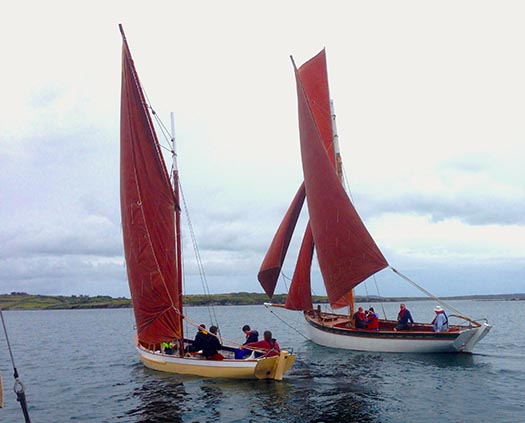
West Cork types will be much in evidence at the Baltimore Wooden Boat Festival from May 22nd to 24th. This is a classic mackerel yawl with a lobster yawl
Then the Dublin area is busy at the end of May and early June, with the DBOGA Riverfest from Poolbeg from May 30th to June 1st, while six days later, the long-established Lambay Race at Howth on June 6th now has a significant classic input with the 117-year-old jackyard topsail-setting Howth Seventeens being joined by both Old Gaffers and Classics.
Inevitably, choices have to be made as the season gains momentum, and the final weekend of June sees both the Portaferry gathering as already mentioned, and the Cobh Traditional Boat Festival on Cork Harbour from June 26th to 28th, with "traditional" naturally taken to include the 1895-vintage Fife-designed Cork Harbour One Designs.
The CHODs will also be starring in this year's main event, the Glandore Classics from July 18th to 24th. This shows every sign of being the biggest Glandore Classic Regatta ever, as the fleet will include a substantial number of Old Gaffers in the early stages of an OGA three week cruise-in-company from Kinsale to West Kerry, while the sailing will be something of a Fife Festival, as the CHODs will be sharing the same racing waters as the visiting Fife ODs from North Wales.
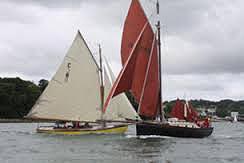
Cork Harbour One Design and Heard 28 Tir na nOg (Sean Walsh) managing to avoid each other at the Glandore Classic Regatta 2013.

Fife OD from the Menai Straits racing at Glandore Classics. Thanks to their wide side-decks, they can sail at an angle of heel unimaginable in most small keelboats, and some helmsmen reckon that the immersed lee deck provides useful lateral resistance
A notable feature of the North Wales Fifes is their wide side decks, which enable these pretty boats to heel a long way without taking water into the cockpit. In fact, it's said that some Fife helmsmen from the squally home waters of the Menai Straits reckon that if they heel their boat enough, the lee deck becomes a sort of secondary keel, and provides significant lateral resistance to enable them to continue to make to windward at an angle of heel which would have any other boat either sinking, or completely out of control, or just sliding sideways out of the picture altogether.......
Make of that what you will, but as we move on round the coast we find that currach racing becomes the dominant passion until the home waters of the Galway Hookers are reached, with the single exception of the one shining star, the Shannon Hooker Sally O'Keeffe at Kilrush, community-built at Querrin on the Loop Head Peninsula, and as sweet a little cutter as you'll see anywhere. Then on north, and we're into Galway Bay with each little port well filled with its quota of bad mor, leath bhad, gleiteog and pucaun.
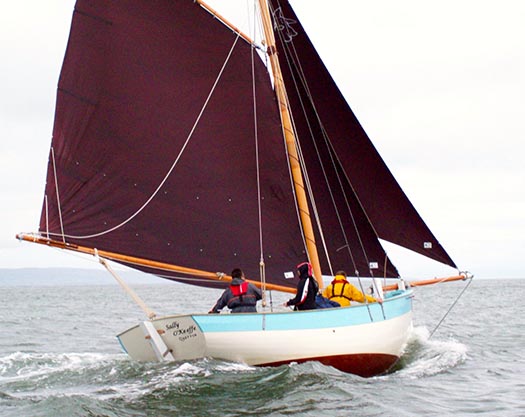
The sweetest thing in the west – the Shannon Hooker Sally O'Keeffe of Querrin on the Loop Head Peninsula
But what, you might well say, was all this about Achill Island? Well, there is a distinct species of local vessel in Achill Sound known as the Achill yawl which, with a single-sail lug rig which is almost a lateen, has a distant relationship to the classic Galway Bay pucaun.
But they have their own way of doing things in Achill Sound. At the peak of the boom years, every pub along the Sound, and local men who had done well in business abroad, between them supported a substantial fleet of Achill yawls which were raced in high summer and early Autumn with a ferocity which was astonishing even to sailmaker Des McWilliam of Crosshaven.
Heaven knows but Des has had enough experience of ferocious racing at all levels of the sport in all sorts of places. But when he went to far Mayo with a new set of threads for a keen Achill yawl owner, naturally as a diligent sailmaker he went afloat for a trial race, and came away suitably chastened by it all.
"We're just big pussy cats in Cork Harbour by comparison with Achill Sound" he reported. "In Achill racing" said he, "they take no prisoners". Yet even the hard men of Achill Sound had to ease back on their enthusiasms when the construction industry fell off a cliff. But just last September, crossing Achill Bridge, I spotted a bit of launching activity. It looks as though Achill yawl racing is showing signs of life again. But it won't be for the faint-hearted.
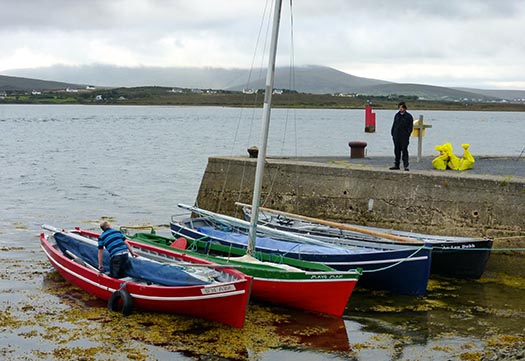
Achill yawls come in several shapes, and the most successful is not necessarily the fastest-looking. Photo: W M Nixon































































